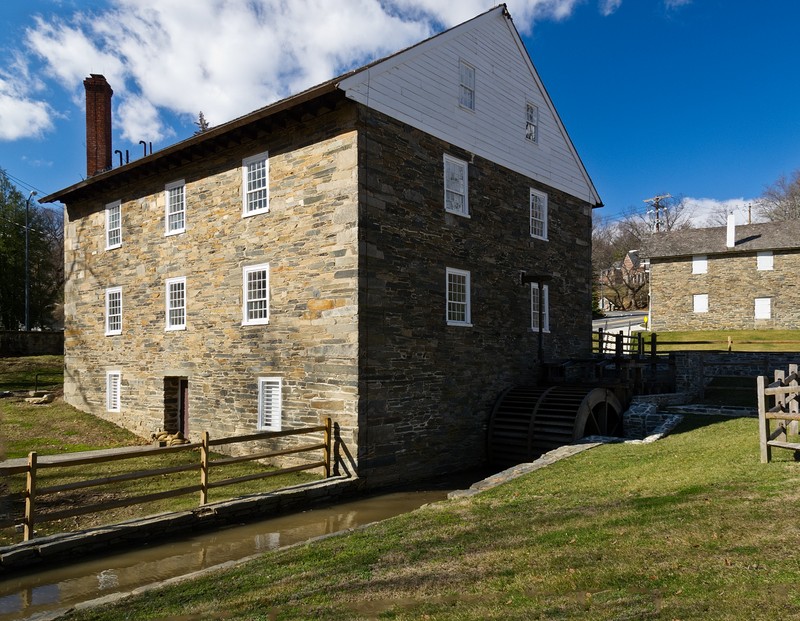Peirce Mill
Introduction
Text-to-speech Audio
Images
Pierce Mill tailrace by Bonnachoven on Wikimedia Commons (CC0 1.0).

Backstory and Context
Text-to-speech Audio
Milling grain into flour has been a labor-intensive process throughout most of human history. The farmland in the area where Washington D.C. now stands produced a variety of grains -- generally wheat, rye, and corn -- which transformed into flour at small mills powered by water wheels turning grindstones. The wave of technological development of the Industrial Revolution brought mechanization to milling, and the inventions at Peirce Mill allowed it to be operated by a single miller.
Quaker farmer and large landholder Isaac Peirce (1756-1841) constructed this blue granite mill in 1829 with his son Abner (1785-1851), a stone mason. A stone plaque on south gable of the mill reads B. I. P. 1829. This could stand for Betty and Isaac Peirce, 1829, (a reference to Peirce's wife Elizabeth) or "Built by Isaac Peirce, 1829."American inventor Oliver Evans (1755-1819) designed the patents for the machinery here which Peirce replicated. Water from Rock Creek turned a wheel attached to a shaft which moved gears and belts to grind grain. Peirce owned and operated the mill, but the millers themselves were hired men.
Abner Peirce operated the mill from his father's death in 1841 to his own ten years later. His nephew Peirce Shoemaker (1816-1891) inherited the mill and operated it for another forty years. Upon his death, the federal government purchased the mill as part of the parcel that was to become Rock Creek Park. The mill continued to grind flour until a broken shaft in 1897 halted operations. The Peirce Mill Tea House opened in the building in 1906 and ran for almost thirty years. Briefly its proprietor was an African-American woman, Hattie L. Sewell; the complaints of a racist neighbor forced her from the business after only a year. The tea house closed entirely in 1934 when a Works Progress Administration undertook a project to restore the mill to working order. The New Deal had transferred the whole park to the National Park Service the previous year.
When the mill reopened in 1937, 2600 spectators watched it come to life again. The mill has required several additional maintenance projects throughout the twentieth and twenty-first centuries, most recently in 2011 when it was restored with funds from the American Recovery and Reinvestment Act. The mill is open to the public as part of the park, with milling demonstrations twice a month on Saturdays between April and October.
Sources
Browne, Allen C.. A Machine in a Stone Box, Historical Marker Database. December 18th 2014. Accessed October 4th 2020. https://www.hmdb.org/m.asp?m=125275.
DeFerrari, John. Rock Creek Park's Historic Peirce Mill Recalled to Life, Streets of Washington. September 25th 2011. Accessed October 4th 2020. http://www.streetsofwashington.com/2011/09/rock-creek-park-historic-peirce-mill.html.
National Park Service. Peirce Mill, Rock Creek Park. December 16th 2018. Accessed October 4th 2020. https://www.nps.gov/places/peirce-mill.htm.
https://commons.wikimedia.org/wiki/File:Peirce_Mill_tailrace.jpg
